This is one of my favorite recipes, because the sauce is super simple and super versatile, it’s nearly impossible to ruin, but it relies so much on your judgement. The more you hone your palate and your cooking instincts, the better this dish becomes.
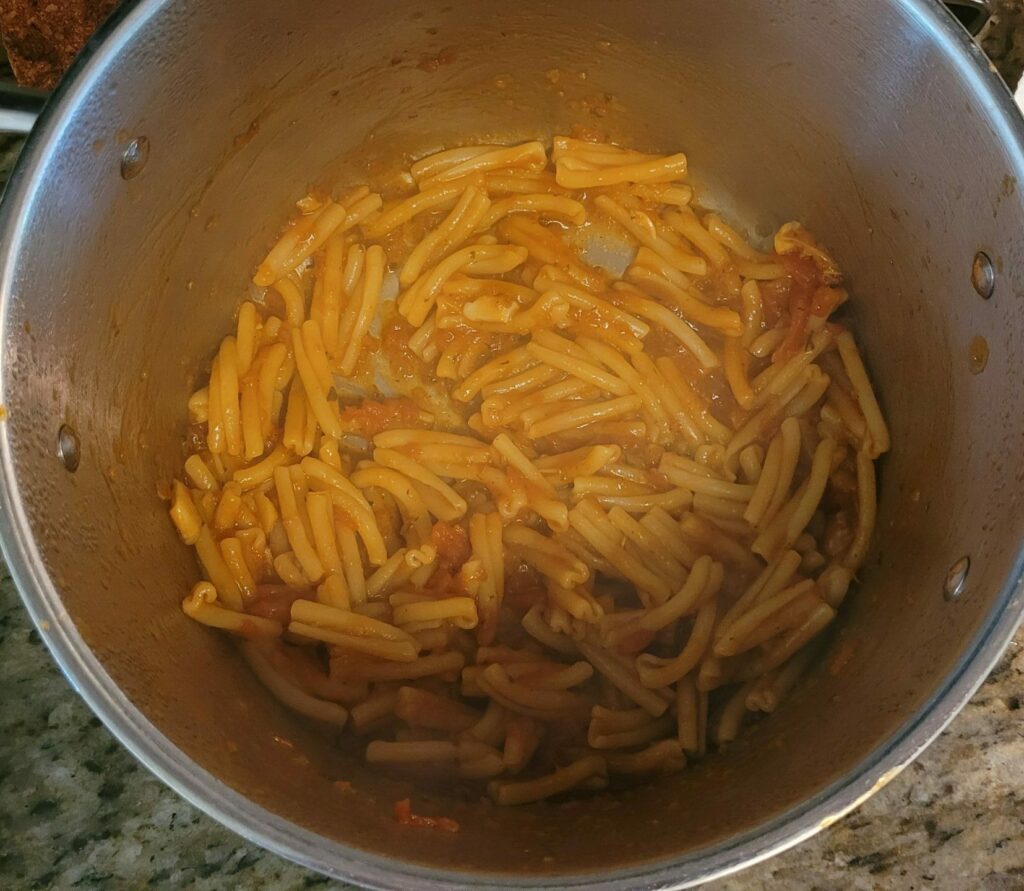
Cook time: 45 minutes
Preparation steps:
- Cut an onion in half and remove the papery outer layer
- Smash and roughly chop the garlic
- If desired, puree the tomatoes (I use a stick blender and puree directly in the can, but this is not necessary)
Notes: I typically go with roughly 4 oz of pasta per person, but that’s up to you. This sauce works with most pasta, except thin ones like angel hair. I think it works best with cut pasta like penne, rigatoni or these casarecce pasta from Costco. This recipe will make enough sauce for 1 lb. of pasta.
Don’t use seasoned canned tomatoes.
You can puree after the sauce is cooked, but that emulsifies some of the butter fat with the water, resulting in a sauce that is more orange than red. This is purely aesthetic and doesn’t affect the flavor.
Ingredients
- 2 Tbsps unsalted butter
- Half of a yellow onion
- 3 cloves of garlic
- 14.5 oz can of diced tomatoes
- Salt to taste
- Sugar to taste
- White wine vinegar to taste
- Pasta (see notes)
Substitutions & Remixes
- Instead of diced tomatoes, you can use a 14 oz can of tomato sauce or 3-4 fresh Roma tomatoes
- Salted butter can be used instead of unsalted–you’ll just need to add less salt while cooking
- Red wine vinegar or apple cider vinegar can be used instead of white wine vinegar
- The original recipe doesn’t call for herbs, but you can jazz yours up with oregano, basil, parsley, carrot greens, etc.
- You can add larger ingredients along with the sauce at the “Bringing It Together” step
- Sliced and sauteed mushrooms
- Cooked ground beef or chicken
- Meatballs
- Puree other vegetables (carrots, summer squash, celery) along with the tomatoes for additional nutrition
- Reserve part of the onion from the sauce, puree it and add it back to the sauce more a more oniony flavor
Pair It With
- Side salad
- Garlic bread
- Breadsticks
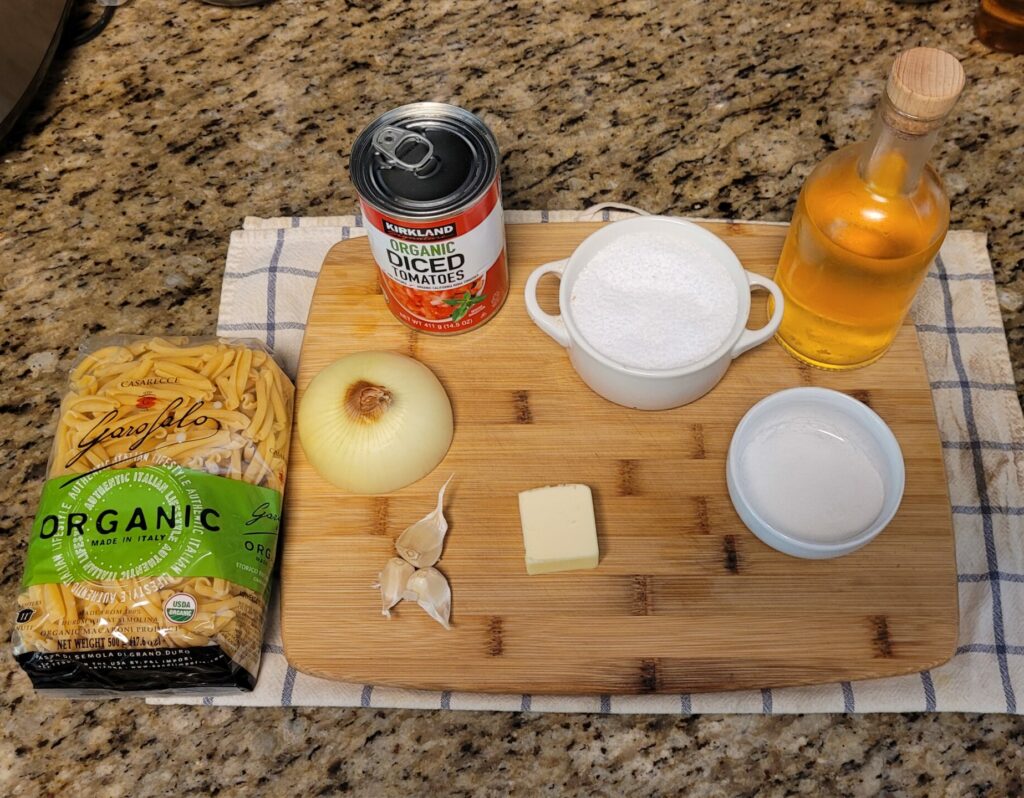
Pasta
We’re going to use a two-stage cooking process for the pasta. You can do the first stage at any point, even the day before, if you want. I typically cook the pasta while the sauce is thickening, so that it is ready to use when the sauce is done. The second stage will take place after the sauce is complete.
- Fill your largest pot with enough water to cover the pasta by several inches.
- Add a couple of heavy pinches of salt. The water should taste a little salty, but not too much. We don’t want the pasta to get too salty as it cooks.
- Bring the water to a boil. Putting a lid on the pot will help speed up the process.
- Once the water is boiling, add the pasta and stir to make sure none of it is sticking to the bottom of the pot, or to each other.
- Use the instructions on the box as a general guide, but don’t ever take them at face value. Always test your pasta as it is cooking, so you can tell when it is done and not accidentally overcook it. I normally start checking my pasta 2-3 minutes before the box says it should be done. Just pull one piece of pasta out and give it a nibble. You’re looking for that perfect point where the pasta is still firm, but not crunchy. When you bite into it, you should feel some resistance. This is what the Italians call al dente. If your pasta isn’t al dente, let it continue cooking for another minute or two, then check again.
- When your pasta is cooked, use a coffee mug or glass measuring cup to scoop out about a cup of the cooking water. You’ll want to wait until the very end of the cooking process. The cooking water will contain a lot of starch that was released by the pasta during cooking. We’ll use this starchy water in the second stage, to help bring the dish together.
- Drain the pasta in a colander and rinse with cold water until it reaches room temperature. We want to completely halt the cooking process at this stage, so the pasta doesn’t get mushy before we’re ready to use it.
- Taste the pasta to get an idea of how salty it is. Keep this in mind when it comes time to season the sauce.
- Set the pasta aside until the sauce is complete.
Sauce
- Add the butter to a pot over medium heat.
- Let the butter melt, then start to bubble and foam.
- Add the onion in, cut side down.
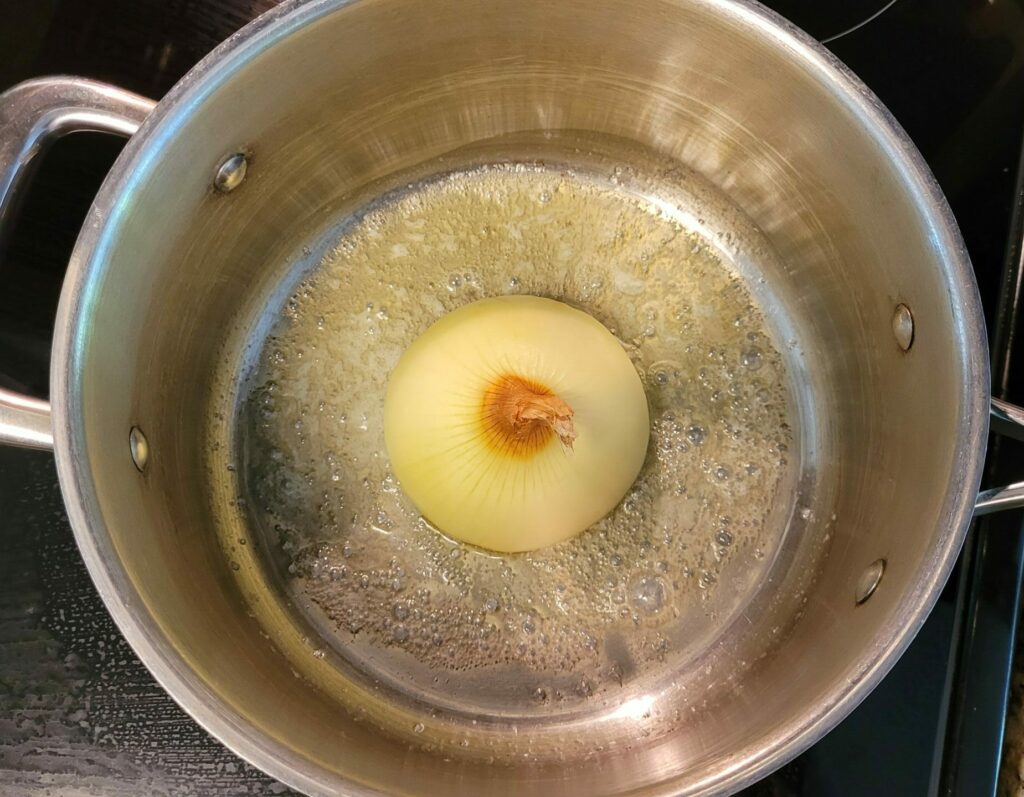
- Onions have flavor compounds that are fat soluble, so you’ll want to make sure as much of the onion’s surface is touching the butter to maximize the release of these compounds.
- Cook, undisturbed, over medium heat until the onion starts to smell toasted.
- Add the garlic with a pinch of salt.
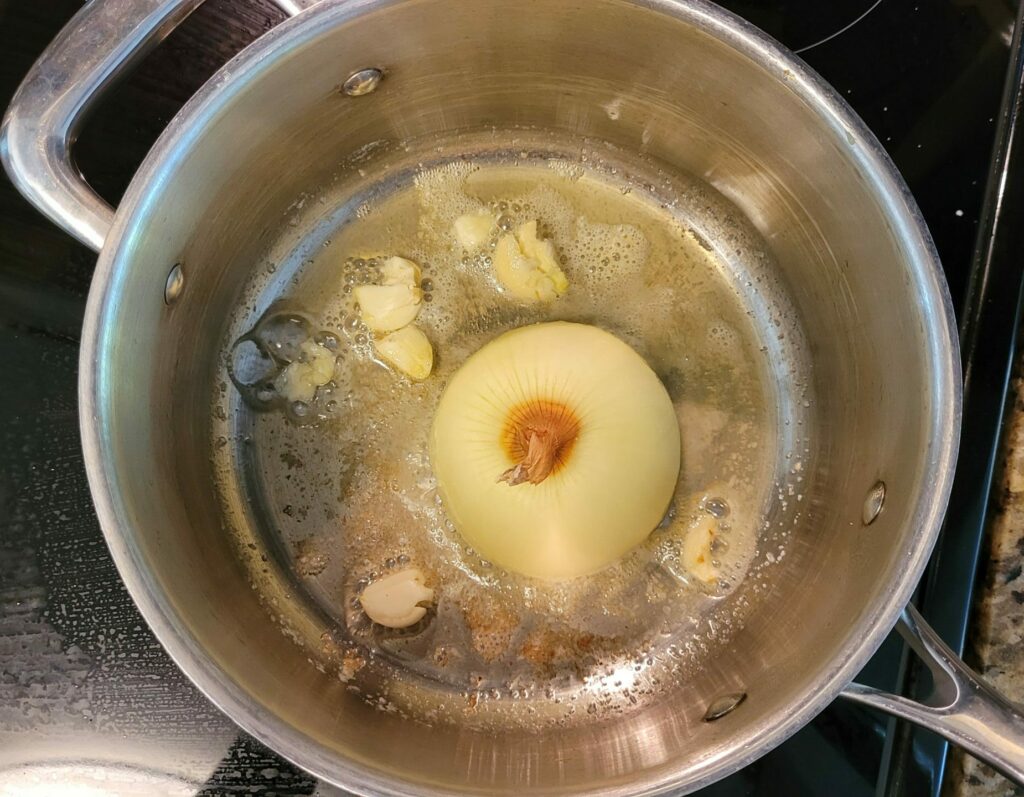
- Cook the garlic until fragrant, but not fried (about a minute, or so).
- Add the tomatoes with a heavy pinch of salt.
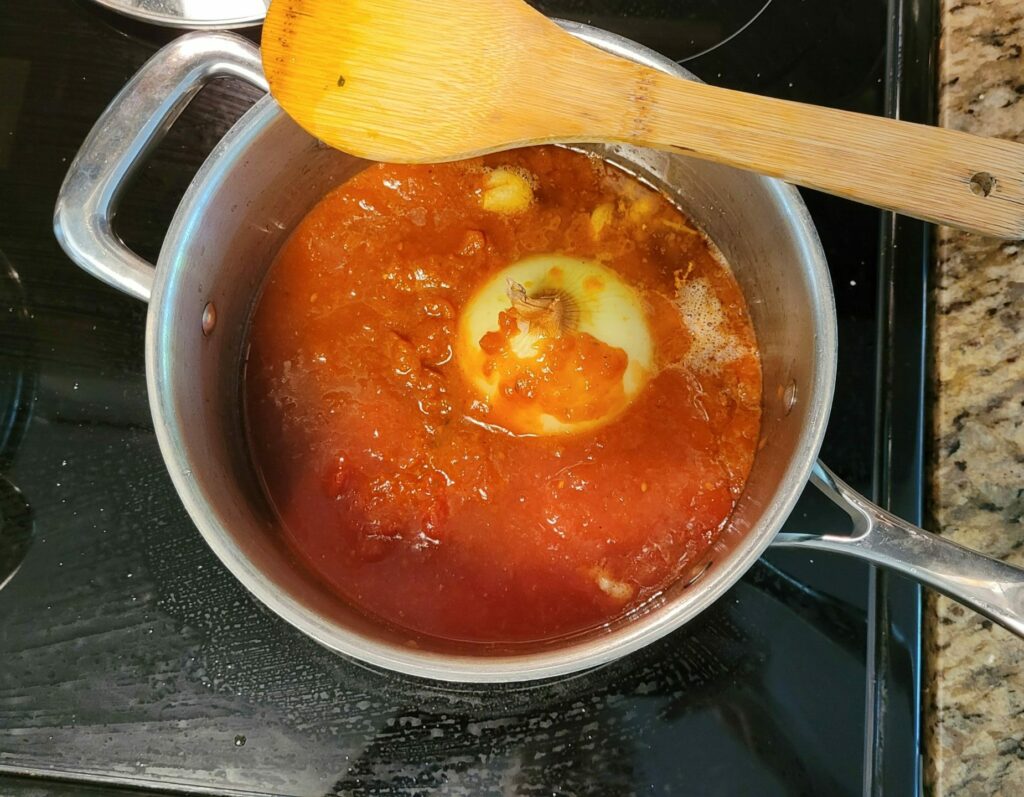
- Give everything a nice stir and bring the sauce up to a simmer.
- Cover partially with a lid and let it simmer for 30 minutes, stirring occasionally to prevent burning. This is a good time to start the pasta.
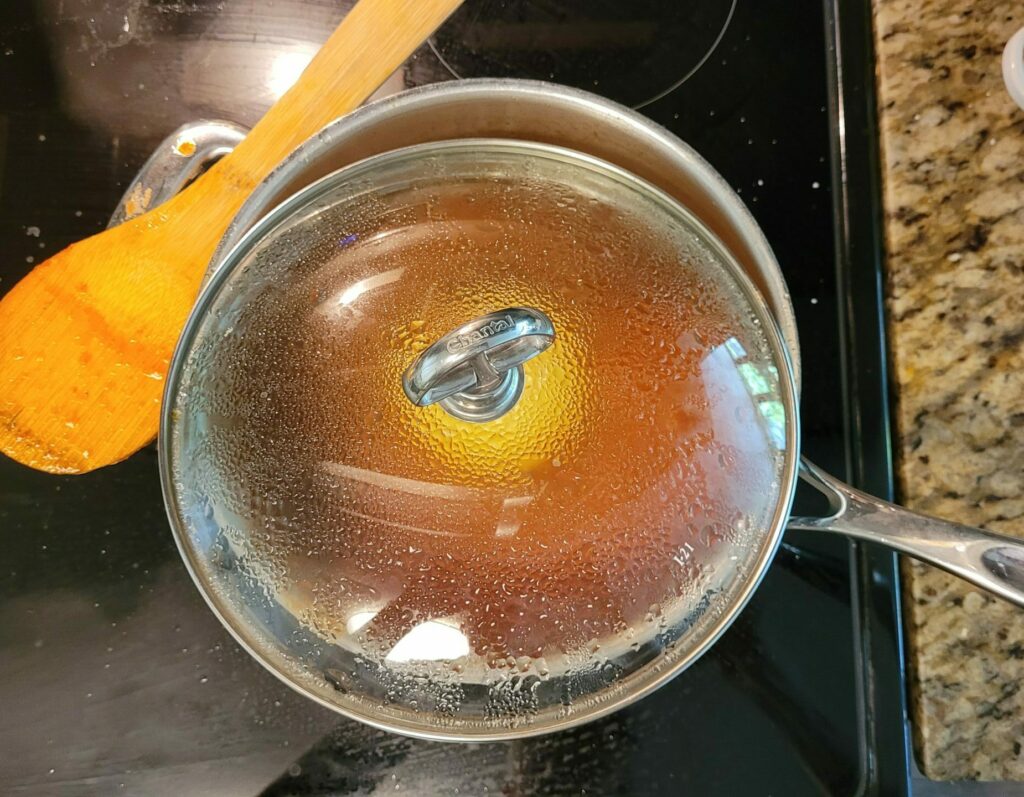
Covering the pot partially will help regulate how much water evaporates out of the sauce. It will also help keep down the mess. As the sauce thickens, it will have a tendency to bubble and gurgle, throwing sauce droplets out onto your stove top. The lid will prevent most of that from getting out of the pot. This 30-minute simmer will help the tomatoes break down and will coax some of the water-soluble flavor compounds from the onion and garlic.
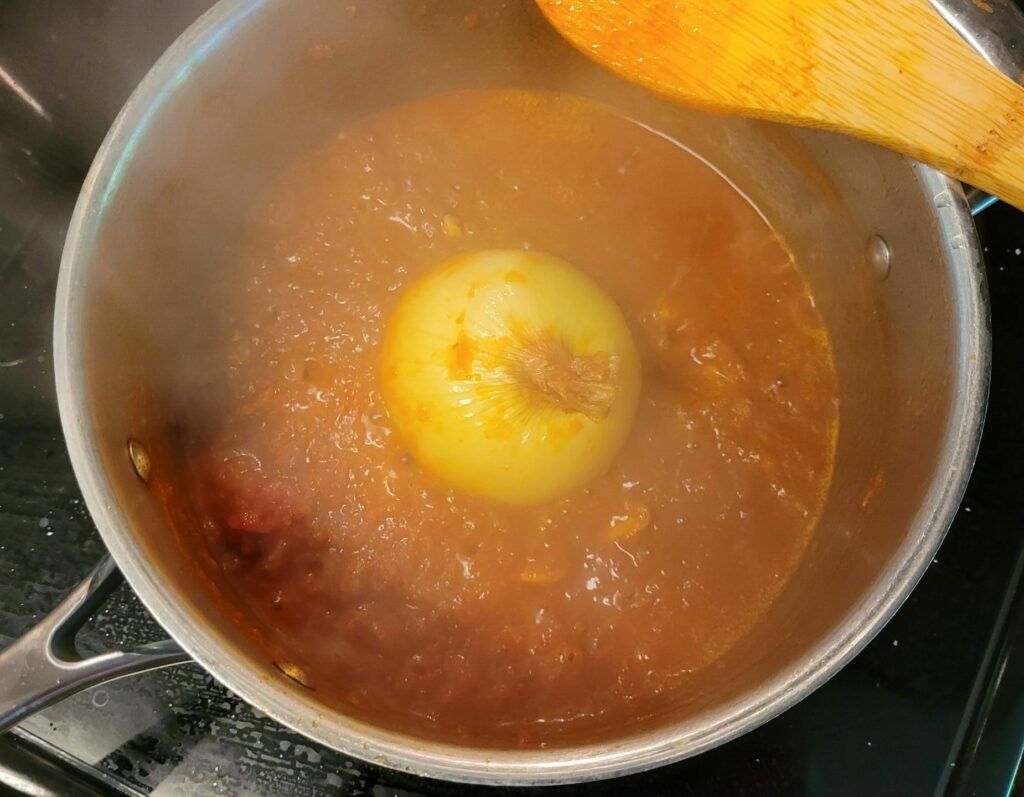
- As the sauce simmers, you’ll notice that the solids separate out and settle to the bottom, while the top layer is mostly water. Keep stirring to recombine these layers.
- After 30 minutes, you should see that the sauce has thickened noticeably and that the water layer on top has gotten thin. When you stir the sauce, it should have the consistency of a store-bought jar of pasta sauce.
- When the sauce has reached the desired consistency, remove and discard the onion. If the garlic cloves are still large enough to fish out, remove and discard those as well. If they’ve broken down into small pieces, it’s fine to leave them in.
- Now, it’s time to season. Depending on the quality and sugar content of both your tomatoes and your onion, the seasoning you use, and the amounts of those seasonings, will vary. Raw tomatoes have a complex flavor that’s mildly sweet, a little bit acidic and very savory. Cooking tomatoes tends to flatten all these flavors out into something that is considerably less complex. We want to tease that complexity back into the sauce. To do that, we’ll use a mixture of salt, vinegar and sugar.
- Taste the sauce. It will likely need salt. Keep in mind how salty the pasta is when you’re salting the sauce.
- Add a pinch of sugar and a teaspoon of vinegar. Taste again. We’re not looking for sweet sauce or acidic sauce, we’re looking for a bright sauce that tastes like tomatoes.
- Keep adjusting and adding small amounts of salt, sugar and vinegar until the sauce tastes good to you. This might take a few additions of each seasoning. It might taste perfect without anything. Rely on your taste buds to let you know when you’ve got it right.
Bringing It Together
With the pasta boiled and the sauce complete, it’s time to bring them together.
- Place the large pot you used to boil the pasta over high heat.
- Pour about half of the reserved cooking water into the bottom of the pot. It should cover the bottom in about half an inch of water.
- When the water starts to boil, reduce the heat to medium, dump in the cooled pasta and swirl it around with a slotted spoon or pair of tongs. The goal here is to coat the pasta with the boiling water.
- After a few swirls, start adding the tomato sauce, a spoonful at a time, swirling with the spoon or tongs to coat the pasta. We want the pasta coated in the sauce, not swimming in it. If you made less than a pound of pasta, you probably won’t need all the sauce.
- If the sauce and pasta aren’t coming together, add a little more of the cooking water. The starch in the water will help bind the sauce to the pasta.
- Continue to stir and swirl vigorously until all the excess water has boiled off and the pasta is nicely coated with sauce.
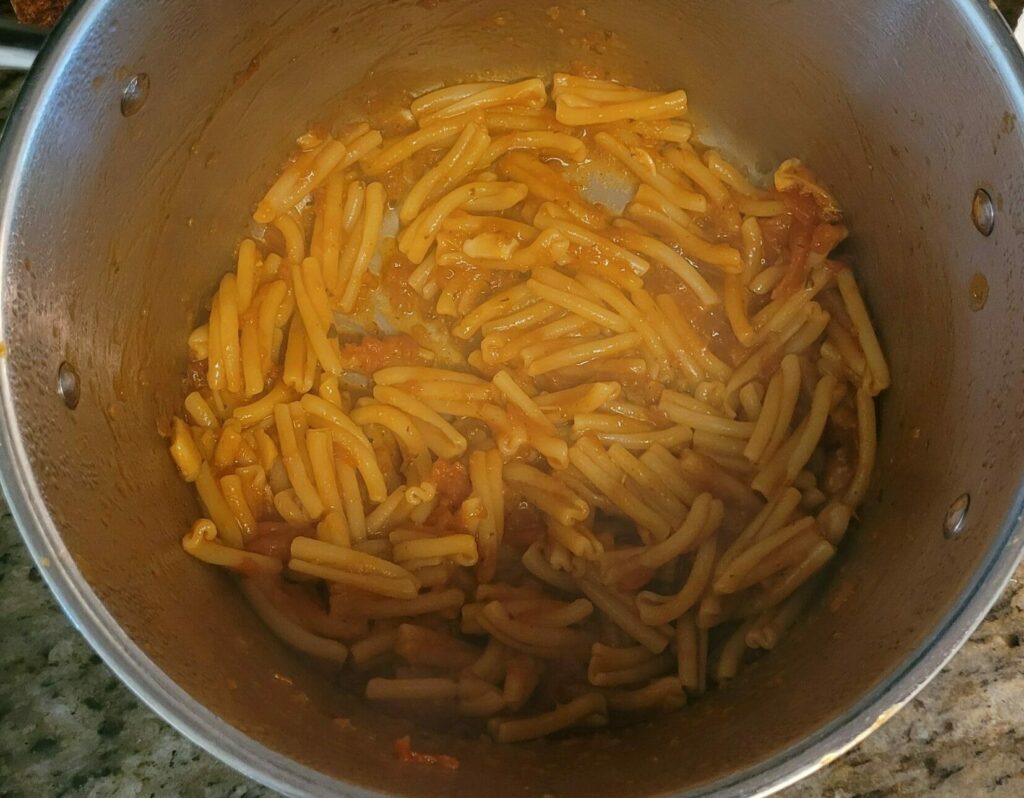
Eat!